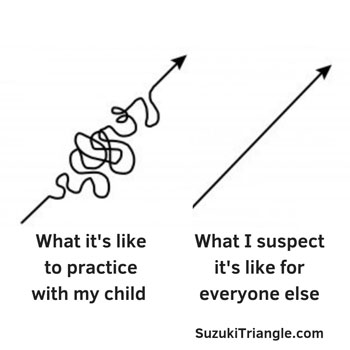Trust the process
Confidence comes from knowing that your route will take you where you want to go.

Confidence comes from knowing that your route will take you where you want to go. Whether it’s about the mastery of a certain piece of music or about the long road to become a confident player, it’s about trusting that the process will get you there.

Well into our seventh year of practicing together, you would think that my daughter and I would have figured everything out by now. And you would be wrong. Perfectionism, self-doubt, and a realization of just how long the road is have recently conspired to make for some difficult practice sessions for us. Here are some of the things I learned while navigating all of this. Mostly, I learned how to help my child trust the process of improvement. It may be true that “Where love is deep, much can be accomplished,” but only because love involves both trust and a willingness to find ways to make it work.
Is our process trustworthy?
In thinking about trusting our process, I looked at how trustworthy our process is.
Trustworthy practice is:
Intensely focused on improving specific performance. In other words, you’re not aiming for some vague qualitative improvement. You’re aiming for specific, identifiable, almost quantifiable aspects of performance. Jason Haaheim, principal timpanist for the MET Orchestra described his process as: “Breaking down the elements of musicality into tangible different projects I can work on."^[This is from a long interview that he gave with Noa Kageyama on the Bulletproof Musician podcast entitled ‘On Practice, Talent, Motivation, and Playing the Long Game.’ Not only is Jason’s story incredibly inspiring, but the detailed description of his practice and preparation process contains a multitude of great ideas.] Isn’t that a wonderful description of deliberate practice?
My practice process involves breaking down the elements of musicality into tangible different projects I can work on.
Can you turn elements of musicality into small practice projects? I sometimes think of this process like a trip to the optometrist. They don’t ask you to evaluate your vision in some global sense. Instead they give you choices: “Is A or B clearer?” The closer we can get to that sort of objectivity the better.
Everyone can improve something every single day. If you’ve never played a note on the violin, you can still learn and improve something about the violin today. The compounding effects of time and persistence take care of the rest. The trick for parents and teachers is to help identify the bits and pieces of musicality and technique that can be turned into practice projects that are achievable within the child’s attention span and the limits of her patience.
Guided by feedback. One of the amazing aspects of musical communities is the spirit of generosity that surrounds us. Young musicians have no shortage of mentors (including their parents) who can give patient developmental feedback.
Always patient. Since we may be our worst critic, self-compassion should be a first priority. Hippocrates said “Life is short, but the art is long.” The road to mastery of one’s instrument or even a given piece of music is long. We have to accept that immediate results are unrealistic. We constantly have to recalibrate our goals.
Have you done this before?
The anxiety over learning a difficult new piece is nothing new. Learning to trust the process of improvement is partly about recognizing that this happed before. I remind my daughter that even “Long, Long Ago” was once a difficult piece and we talk about what allowed her to get past it. The repertoire may be graded so that there are no giant leaps in difficulty; but that doesn’t mean that ever child experiences it in the same way. Children can trust the process because they’ve done it before in small incremental steps.
Is the road supposed to be straight?
Suzuki violin teacher and author, Christine Wilson Goodner poignantly illustrated how our expectations about practice and improvement diverge from the reality.

No, the road is not supposed to be straight. It is full of setbacks, switchbacks, and detours. What you play well today may not sound as good tomorrow. By anticipating diversions, we can better trust the road to improvement from the “big picture” perspective. And even if the practice session results in not very much improvement, you can trust that there is a cumulative relational effect of all these hours of time spent together doing something constructive.
I don’t know, what would you do?
Trust and agency go hand-in-hand. Eventually we want our children to be able to credibly say: “I can trust the process because I have a hand in it.” We should always look for opportunities to help kids self-evaluate progress, solve problems, and help prioritize practice.
Hopefully, you can say that no matter what the outcome, you and your child are better off for having taken the trip together. Fortunately, Suzuki was interested not only in where the road was going but how we get there and what we can learn along the way.





